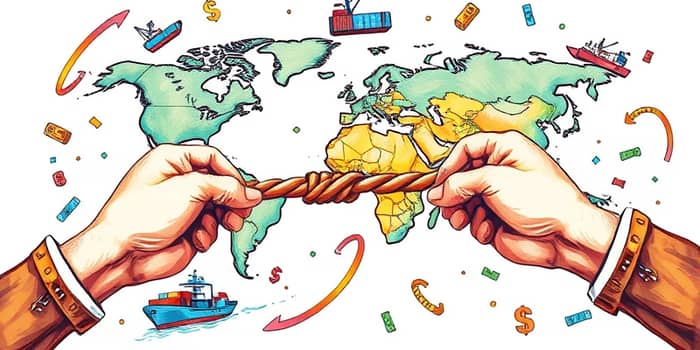
In an era of rapid global connectivity, international commerce is no longer just an economic exchange—it has become a stage for geopolitical strategy. The interplay of tariffs and trade tensions reverberates through markets, boardrooms, and kitchen tables worldwide. Understanding these dynamics is critical for businesses, policymakers, and individuals seeking clarity amid uncertainty.
Trade wars date back centuries, but their modern incarnation features high-stakes tariffs targeting steel, agriculture, technology, and more. At their core, tariffs protect domestic industries by taxing imports, while trade wars occur when nations retaliate in kind. In 2025, the U.S. has been locked in significant confrontations with China, Mexico, and Canada, each move sparking new rounds of duties on goods ranging from semiconductors to tortillas.
This escalation has altered supply chains and diplomatic ties alike. As nations adopt a more assertive posture, the very concept of free trade is being recalibrated. What once was a seamless flow of goods now looks like a mosaic of negotiated exemptions and punitive measures.
The most immediate toll of tariffs is often felt by consumers. Studies estimate that U.S. tariffs enacted in 2025 have driven up consumer prices by an average of 1.7% in the short run and 1.4% after substitution. For the typical household, this translates into a loss of purchasing power of roughly $2,800 initially and $2,300 once adjustments are made.
On a broader scale, these measures shave off nearly 0.7 percentage points from real GDP growth and push unemployment higher by about 0.35 points. By year’s end, payroll employment could be nearly half a million jobs lower than it would have been without new duties.
Sectoral shifts add another layer of complexity. While manufacturing output is projected to rise by 2.5%, industries like construction and agriculture face contractions. This uneven landscape forces workers and firms to adapt or relocate, often at significant cost.
At the heart of trade dynamics is comparative advantage—each nation leverages its strengths. Canada’s dense oil reserves, for example, make it a crucial energy partner for the U.S. Yet when tariffs strike, these natural synergies waver. Mexico and Canada have enacted retaliatory duties, targeting U.S. agricultural products and manufactured goods in response to American levies.
The U.S.-China relationship exemplifies this tug-of-war. China remains a top destination for U.S. exports while simultaneously supplying critical imports. Each tariff announcement sends shockwaves through global markets, prompting companies to diversify their supply chains and governments to recalibrate diplomatic strategies.
State-level impacts within the U.S. are equally varied. Regions reliant on high-tech manufacturing may fare better than those anchored in commodity exports. Policymakers must therefore tailor responses to local vulnerabilities and strengths to mitigate substantial real income losses in hard-hit areas.
Heightened trade frictions elevate overall economic uncertainty, altering the calculus for investors and executives alike. Firms now list trade policy instability among their top concerns, prompting moves to shorten supply chains and secure alternative suppliers in more stable jurisdictions.
Prudent strategies include:
By proactively adjusting, businesses can transform challenges into competitive advantages, positioning themselves for growth regardless of which way the geopolitical winds blow.
Beyond national borders, trade wars affect integrated manufacturing networks around the world. The automotive sector, for instance, operates on cross-border supply chains that span dozens of countries. A single tariff can force companies to reroute components, incurring logistical and financial burdens.
Certain economies—China, Mexico, and Canada among them—face real income losses” that ripple through consumer spending and investment. Emerging markets, heavily dependent on commodity exports, must also contend with reduced demand and price volatility.
Looking ahead, the long-term impact of these disputes will hinge on adaptability. Countries that embrace technological innovation, diversify trade partnerships, and forge robust regional agreements will likely emerge stronger.
Policymakers bear the critical task of balancing protectionist impulses with the need for sustained growth and stability. Crafting agreements that safeguard key industries without stifling competition will be essential to weathering future geopolitical storms.
Ultimately, trade wars and tariffs are more than economic levers—they are reflections of national priorities and global ambitions. By understanding their effects, stakeholders can navigate uncertainty with resilience and vision, ensuring that commerce remains a conduit for shared prosperity rather than a battlefield of competing interests.
References













